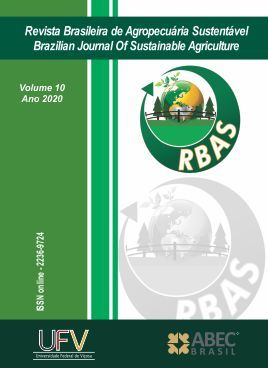GROWTH AND PHYSIOLOGY OF YOUNG GRAPEVINES (CV. BRS CARMEM) UNDER ORGANIC AND BIODYNAMIC PRODUCTION SYSTEMS
DOI:
https://doi.org/10.21206/rbas.v10i1.9562Palabras clave:
Vitis spp., vegetative growth, enzymes, photosynthesis, agroecologyResumen
The biodynamic cultivation method consists of seeing the farm as an agricultural organism; its main goal is soil fertility, along with a rich diversity and biological activity. The objective of this work was to evaluate the growth, the physiology and the yield of grapevines cv. BRS Carmem, comparing organic and biodynamic production systems. The experiment was conducted under field conditions in Guarapuava, Paraná State, Southern Brazil planted in September 2013 and evaluated until June 2017. The experimental design was a randomized block with two treatments and six replications. In the plots of biodynamic treatment the following biodynamic preparations were applied: silica horn (501), manure horn (500), 508 (Equisetum hyemale L.) and Fladen. All plants were fertilized with the same organic compost, however, those from the biodynamic treatment received the preparations 502 (Achillea millefolium), 503 (Chamomilla officinalis), 504 (Urtica dioica), 505 (Quercus robus), 506 (Taraxacum officinale) And 507 (Valeriana officinalis). During three consecutive growing seasons the following variables were evaluated: enzyme activity (EC 3.2.1.39) ? 1,3 glucanase and (EC 3.2.1.14) chitinase, mildew severity Plasmopara viticola, leaf water potential, gas exchange, chlorophyll fluorescence, SPAD index, Measurements of length and diameter of the canes, trunk diameter, weight of the pruning material, number of clusters, cluster length, berry diameter and soluble solids concentration. Biodynamic treatment promoted at least one year greater growth of plants (length and diameter of canes trunk diameter and SPAD index), better physiological response (leaf photosynthetic activity, Rubisco enzyme efficiency, maximum quantum yield of PSII), biochemistry (ß 1,3 glucanases and chitinase enzymes) and consequently greater resistance to disease and productivity.
Descargas
Descargas
Publicado
Cómo citar
Número
Sección
Licencia
1. Proposta de Política para Periódicos de Acesso Livre
Autores que publicam nesta revista concordam com os seguintes termos:
Autores mantém os direitos autorais e concedem à revista o direito de primeira publicação, com o trabalho simultaneamente licenciado sob a Licença Creative Commons Attribution que permite o compartilhamento do trabalho com reconhecimento da autoria e publicação inicial nesta revista.












